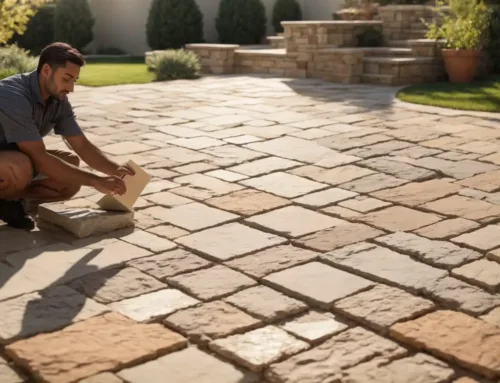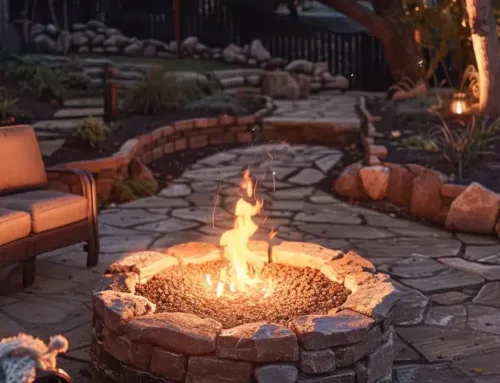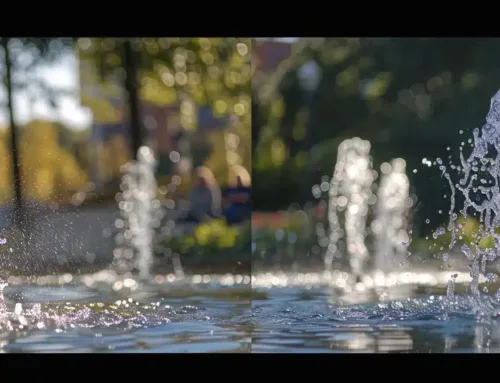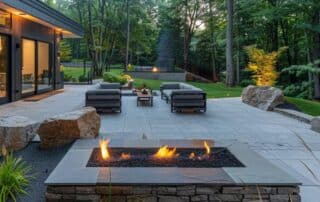Are you unsure about which materials to choose for your custom fire pit? Selecting the right materials is crucial for both aesthetics and functionality. In this post, I will guide you through the various options available, including metal choices like steel and copper, as well as stone and masonry selections. You’ll learn how to consider factors like maintenance and safety, ensuring your fire pit not only looks great but also performs well. By the end, you’ll have the knowledge to make informed decisions for your outdoor space, whether you’re building a smokeless fire pit or incorporating a retaining wall.
Key Takeaways
- choose durable materials like stone and cast iron for long-lasting fire pits
- consider natural gas for easy ignition and consistent heat in your fire pit
- prioritize safety by ensuring proper ventilation and distance from flammable materials
- customize your fire pit design with unique material blends for a personal touch
- maintain your fire pit regularly to ensure its beauty and functionality over time
Understanding Available Materials for Custom Fire Pits

When selecting materials for your custom fire pit, it’s essential to consider commonly used options like brick, stone, and metal. Each material varies in durability and lifespan, which impacts your investment. Additionally, heat resistance and safety are crucial for a secure patio experience. Lastly, the aesthetic versatility of these materials allows for unique designs that enhance your landscape. Let’s explore these aspects in detail.
Commonly Used Materials in Fire Pit Construction
When I design custom fire pits, I often choose stone as a primary material due to its durability and natural beauty. Stone fire features, especially those made from granite, not only withstand high temperatures but also add a rustic charm to any outdoor space. The right choice of stone can enhance the overall aesthetic of your landscape while providing a sturdy base for your fire pit.
Incorporating natural gas into your fire pit design is another consideration I frequently discuss with clients. Using natural gas allows for easy ignition and consistent heat, making it a practical choice for those who want a hassle-free experience. Additionally, ensuring proper airflow is essential for safety and efficiency, as it helps maintain a steady flame and prevents smoke buildup, creating a more enjoyable atmosphere for gatherings.
Durability and Lifespan of Different Materials
When I consider the durability and lifespan of materials for custom fire pits, I often recommend cast iron for its strength and heat retention. Cast iron can withstand high temperatures from the fire pit fire, making it a reliable choice for long-term use. Additionally, when combined with a quality adhesive, it can create a secure and lasting bond with other hardscape elements, ensuring your fire pit remains stable and functional for years.
Limestone is another material I frequently use due to its natural beauty and durability. It can handle the heat generated by the fire pit fire while adding an elegant touch to your outdoor space. However, it’s essential to seal limestone properly to protect it from moisture and wear, which can extend its lifespan significantly. Choosing the right materials and maintenance practices can lead to a stunning and enduring fire pit design:
- Cast iron for strength and heat retention
- Adhesive for secure bonding with hardscape elements
- Limestone for natural beauty and durability
Heat Resistance and Safety Considerations
When designing a custom fire pit, heat resistance is a top priority. I often recommend using materials like concrete block for the fire ring, as they can withstand high temperatures without cracking or degrading. This durability ensures that your fire pit remains safe and functional for years, allowing you to enjoy your yard without worry.
Safety is also a key consideration when selecting materials for your fire pit. If you opt for propane as your fuel source, it’s important to ensure proper ventilation and distance from flammable materials. I always advise my clients to create a clear space around the fire ring, which not only enhances safety but also allows for a more enjoyable gathering area. By focusing on these aspects, you can create a beautiful and secure outdoor space that meets your needs.
Aesthetic Versatility and Design Options
When I design custom fire pits, I focus on the aesthetic versatility that different materials offer. For instance, using masonry allows for a variety of shapes and sizes, including options with a larger diameter that can accommodate more guests. Incorporating a paver base not only enhances the visual appeal but also provides a stable foundation, ensuring your fire pit remains secure and functional over time.
Another material I often recommend is copper, which adds a unique touch to any outdoor space. Its natural patina develops over time, creating a beautiful contrast against the surrounding soil and landscape. By thoughtfully selecting materials, you can create a fire pit that not only serves as a functional feature but also enhances the overall design of your yard, making it a welcoming spot for gatherings.
Choosing the right material for your fire pit is just the beginning. Next, we’ll explore the key factors that will guide your selection and ensure your fire pit fits perfectly in your outdoor space.
Factors Influencing Material Selection for Your Fire Pit

When selecting materials for your custom fire pit, several factors come into play. I assess local climate and environmental conditions to ensure durability. Budget considerations and material costs are also crucial, as they impact your overall investment. Additionally, matching materials to your design style enhances the aesthetic appeal, while understanding installation complexity and skill requirements ensures a successful project. Each of these elements plays a vital role in creating a functional and beautiful fire pit.
Assessing Local Climate and Environmental Conditions
When I assess local climate and environmental conditions for a custom fire pit, I consider how weather patterns can affect the materials I choose. For instance, in areas with heavy rainfall, I recommend using pavers that are resistant to moisture and can handle the weight of the fire pit without shifting. Additionally, ensuring proper ventilation around the fireplace is crucial to maintain a steady flame and prevent smoke from accumulating, which can detract from your outdoor experience.
Another important factor is the type of sand used in the fire pit‘s base. I often suggest using a specific type of sand that can help with drainage and stability, especially in regions prone to flooding or heavy snow. By taking these local conditions into account, I can help you select materials that not only look great but also stand the test of time, ensuring your fire pit remains a safe and enjoyable feature in your yard.
Budget Considerations and Material Costs
When I work with clients on their custom fire pit designs, budget considerations play a significant role in material selection. For instance, while stainless steel offers excellent durability and resistance to rust, it can be more expensive than other options like metal or gravel. Understanding the costs associated with each material helps me guide clients toward choices that fit their financial plans while still achieving the desired look and functionality.
Additionally, I often discuss the long-term value of investing in quality materials. While steel may have a higher upfront cost, its strength and longevity can save money on repairs or replacements down the line. By carefully evaluating the budget and material costs, I can help you create a fire pit that not only meets your aesthetic preferences but also aligns with your financial goals, ensuring a satisfying outdoor experience for years to come.
Matching Materials to Your Design Style
When I work with clients on their custom fire pit designs, I emphasize the importance of matching materials to their overall design style. For example, if your home features a modern aesthetic, sleek materials like stainless steel or concrete can create a clean, contemporary look. On the other hand, if you prefer a more rustic vibe, natural stone or brick can enhance the warmth and charm of your outdoor space, making it feel inviting and cozy.
Understanding your design preferences helps me recommend materials that not only look great but also complement your existing landscape. I often suggest incorporating elements that reflect your personal style, such as using copper accents for a unique touch or choosing pavers that match your patio. By aligning the materials with your vision, we can create a fire pit that serves as a stunning focal point in your yard, enhancing both functionality and beauty.
Installation Complexity and Skill Requirements
When I assess the installation complexity of a custom fire pit, I consider the materials chosen and the skills required for assembly. For instance, using heavy stone or brick may demand more advanced masonry skills, while lighter materials like metal can be easier to work with for DIY enthusiasts. Understanding your comfort level with construction is key, as it helps determine whether you should tackle the project yourself or hire a professional for a seamless installation.
Additionally, I often discuss the importance of proper tools and techniques needed for a successful fire pit installation. If you opt for materials that require precise cutting or fitting, having the right equipment is essential to avoid costly mistakes. By evaluating your skills and the complexity of the materials, I can guide you toward a fire pit design that not only meets your aesthetic goals but also aligns with your ability to execute the project effectively.
The right material can make all the difference in your fire pit‘s look and feel. Let’s take a closer look at the strengths of steel, cast iron, and copper, and see which one fits your vision best.
Exploring Metal Options: Steel, Cast Iron, and Copper

When selecting materials for your custom fire pit, metal options like steel, cast iron, and copper each offer unique benefits. Steel is known for its durability and resistance to rust, while cast iron structures provide excellent heat retention. Copper fire pits bring a distinct aesthetic appeal but may require more maintenance. I’ll also discuss potential challenges with these metal materials to help you make an informed choice.
Benefits of Using Steel in Fire Pits
Using steel for your custom fire pit design offers several advantages that make it a popular choice among homeowners. Steel is incredibly durable and resistant to rust, which means it can withstand the elements and maintain its appearance over time. This durability ensures that your fire pit remains a reliable feature in your outdoor space, allowing you to enjoy cozy gatherings without worrying about wear and tear.
Another benefit of steel is its heat retention properties. Steel fire pits can absorb and radiate heat effectively, providing warmth during chilly evenings. This feature enhances the overall experience of your outdoor gatherings, making it a comfortable space for family and friends. When considering your options, remember that steel fire pits can be both functional and stylish, fitting seamlessly into various landscape designs:
- Durability and rust resistance
- Effective heat retention
- Versatile design options
Advantages of Cast Iron Structures
Cast iron structures are a fantastic choice for custom fire pits due to their exceptional heat retention and durability. When I design fire pits using cast iron, I find that they can hold heat for longer periods, allowing for extended enjoyment during cooler evenings. This feature not only enhances the comfort of your outdoor gatherings but also makes cast iron a reliable option for consistent warmth.
Another advantage of cast iron is its ability to withstand high temperatures without warping or degrading. I often recommend cast iron for clients looking for a long-lasting fire pit solution. With proper care, such as regular cleaning and occasional seasoning, a cast iron fire pit can remain a stunning centerpiece in your yard for many years to come. Here are some key benefits of using cast iron in your fire pit design:
- Excellent heat retention for longer warmth
- Durable and resistant to warping
- Long-lasting with proper maintenance
Unique Qualities of Copper Fire Pits
Copper fire pits are a standout choice for those looking to add a unique touch to their outdoor space. One of the most appealing qualities of copper is its ability to develop a beautiful patina over time, which enhances its visual appeal and creates a distinct character. This natural aging process not only adds charm but also makes each copper fire pit one-of-a-kind, reflecting the personality of your landscape.
In my experience, copper fire pits are also lightweight and easy to move, making them a flexible option for homeowners who like to rearrange their outdoor settings. They conduct heat exceptionally well, providing warmth during chilly evenings, which is perfect for gatherings with family and friends. By choosing a copper fire pit, you can enjoy both functionality and aesthetic beauty, creating a welcoming atmosphere in your yard.
Potential Challenges With Metal Materials
When working with metal materials for custom fire pits, one challenge I often encounter is the potential for rust, especially with steel. While steel is durable, it can corrode if not properly treated or maintained. I always recommend applying a protective coating to help prevent rust and extend the life of your fire pit. Regular maintenance, such as cleaning and reapplying protective finishes, is essential to keep your fire pit looking great and functioning well.
Another issue I see with metal fire pits, particularly with copper, is the need for ongoing care to maintain their appearance. Copper develops a patina over time, which some homeowners love, but others may prefer to keep the shiny look. If you want to maintain that bright finish, you’ll need to clean and polish the copper regularly. Understanding these maintenance requirements can help you choose the right metal for your fire pit, ensuring it meets your aesthetic and functional needs.
Now that we’ve looked at metal options, let’s turn our attention to stone and masonry. These materials bring a timeless beauty and strength to fire pits that can transform any outdoor space.
Stone and Masonry Choices for Fire Pits

When selecting materials for your custom fire pit, I focus on stone and masonry choices that enhance both functionality and aesthetics. I’ll guide you through selecting the right type of stone, incorporating brick and pavers, and utilizing concrete and refractory materials. Additionally, I’ll discuss how to combine stone with other materials for a unique design that complements your outdoor space.
Selecting the Right Type of Stone
When selecting the right type of stone for your custom fire pit, I often recommend considering both durability and aesthetic appeal. Natural stones like granite and bluestone are excellent choices due to their ability to withstand high temperatures and harsh weather conditions. These materials not only provide a sturdy base for your fire pit but also enhance the overall look of your outdoor space, making it inviting for gatherings.
Another important factor is the texture and color of the stone. I find that lighter stones can brighten up a patio area, while darker stones can create a more dramatic effect. It’s essential to choose a stone that complements your existing landscape and home design. By thoughtfully selecting the right type of stone, you can create a fire pit that is both functional and visually appealing:
- Consider durability and weather resistance
- Choose natural stones like granite or bluestone
- Match the stone‘s texture and color to your landscape
Incorporating Brick and Pavers
Incorporating brick and pavers into your custom fire pit design can significantly enhance both its functionality and aesthetic appeal. I often recommend using brick for its classic look and durability, which can withstand the heat generated by the fire. Pavers, on the other hand, offer versatility in design, allowing for various patterns and colors that can complement your outdoor space beautifully.
When I work with clients, I emphasize the importance of creating a stable base for the fire pit using pavers. This not only ensures the fire pit remains secure but also adds a polished finish to the overall design. By thoughtfully selecting the right combination of brick and pavers, you can achieve a stunning fire pit that serves as a focal point in your yard, making it an inviting space for gatherings:
- Choose durable brick for a classic look
- Utilize pavers for design versatility
- Create a stable base for safety and aesthetics
Utilizing Concrete and Refractory Materials
When I incorporate concrete and refractory materials into custom fire pit designs, I focus on their durability and heat resistance. Concrete is an excellent choice for the fire pit base, as it can withstand high temperatures without cracking. Additionally, refractory materials, specifically designed to endure extreme heat, can be used for the fire ring, ensuring safety and longevity in your outdoor space.
Using concrete allows for a variety of design options, from sleek modern looks to more traditional styles. I often recommend combining concrete with decorative elements, such as stone or brick, to enhance the visual appeal of the fire pit. By thoughtfully selecting these materials, you can create a stunning fire pit that not only serves its purpose but also complements your landscape beautifully:
- Durable concrete for the fire pit base
- Refractory materials for heat resistance
- Variety of design options with concrete
- Combination with decorative elements for enhanced aesthetics
Combining Stone With Other Materials
When I design custom fire pits, I often find that combining stone with other materials can create a unique and visually appealing feature. For instance, pairing natural stone with metal accents, like a steel fire ring, not only enhances the durability of the fire pit but also adds a modern touch to the overall design. This combination allows for a striking contrast that can elevate the aesthetic of your outdoor space while ensuring the fire pit remains functional and safe.
Another effective approach I recommend is using stone alongside concrete elements. By incorporating concrete pavers as a base, I can create a stable foundation that supports the weight of the stone while allowing for various design patterns. This method not only improves the fire pit‘s stability but also provides an opportunity to customize the look, making it a perfect fit for your landscape. Combining these materials can lead to a stunning fire pit that serves as a focal point for gatherings and enhances your outdoor living experience.
Stone and masonry offer strength and beauty for fire pits. Yet, there are other materials—like glass and ceramics—that can bring a fresh look and feel to your outdoor space.
Alternative Materials: Glass, Ceramics, and More

Incorporating fire-resistant glass elements into your custom fire pit design can enhance both safety and aesthetics. I often highlight the benefits of ceramic components, which offer durability and unique styles. Additionally, exploring innovative and sustainable material options allows for eco-friendly choices. Customizing with unique material blends can create a truly personalized fire pit that complements your outdoor space beautifully.
Incorporating Fire-Resistant Glass Elements
Incorporating fire-resistant glass elements into your custom fire pit design can significantly enhance both safety and aesthetics. I often recommend using tempered glass panels around the fire pit to create a protective barrier that keeps flames contained while allowing for an unobstructed view of the fire. This not only adds a modern touch to your outdoor space but also helps prevent accidental burns, making it a safer option for gatherings with family and friends.
Another benefit of using fire-resistant glass is its ability to reflect light and create a stunning visual effect. When the flames dance against the glass, it creates a warm and inviting atmosphere that enhances your outdoor experience. I find that incorporating colored glass stones or beads can further personalize your fire pit, allowing you to match the design with your landscape. Here are some key points to consider when using fire-resistant glass in your fire pit design:
- Provides safety by containing flames
- Enhances visual appeal with reflections
- Allows for customization with colored glass elements
Benefits of Ceramic Components
Ceramic components are an excellent choice for custom fire pits due to their durability and heat resistance. I often recommend ceramics because they can withstand high temperatures without cracking, making them a reliable option for long-lasting outdoor features. Additionally, ceramics come in various colors and styles, allowing homeowners to customize their fire pits to match their landscape and personal taste.
Another benefit of using ceramic materials is their low maintenance requirements. Unlike some other materials, ceramics do not rust or corrode, which means they can maintain their appearance with minimal effort. This makes them a practical choice for busy homeowners who want a beautiful fire pit without the hassle of frequent upkeep. Here are some key advantages of ceramic components in fire pit design:
- Durable and heat-resistant for long-lasting use
- Available in various colors and styles for customization
- Low maintenance, avoiding rust and corrosion
Innovative and Sustainable Material Options
When considering innovative and sustainable material options for your custom fire pit, I often recommend exploring recycled glass. This material not only adds a unique aesthetic appeal but also promotes eco-friendliness. Using recycled glass in your fire pit design can create a stunning visual effect, especially when combined with flames, as it reflects light beautifully and enhances the overall ambiance of your outdoor space.
Another sustainable choice I frequently discuss with clients is the use of ceramic materials. Ceramics are durable and heat-resistant, making them ideal for fire pits. They come in various colors and styles, allowing for customization that matches your landscape. Plus, ceramics require minimal maintenance, which is a significant advantage for homeowners looking for a long-lasting and attractive fire pit solution without the hassle of frequent upkeep.
Customizing With Unique Material Blends
When I work with clients on their custom fire pit designs, I often emphasize the benefits of customizing with unique material blends. Combining materials like glass and ceramics can create a stunning visual effect while enhancing the functionality of the fire pit. For example, using fire-resistant glass stones alongside a ceramic base not only adds a pop of color but also reflects the flames beautifully, creating an inviting atmosphere for gatherings.
In my experience, blending materials allows for greater creativity and personalization in your fire pit design. By mixing textures and colors, you can achieve a look that complements your outdoor space perfectly. I encourage homeowners to think about their landscape and choose combinations that resonate with their style, ensuring that the fire pit becomes a focal point that enhances their overall outdoor experience.
Choosing the right material is just the beginning. Next, we’ll explore how to keep your outdoor space safe and beautiful, no matter what you choose.
Maintenance and Safety Based on Material Type

When it comes to maintaining your custom fire pit, understanding the specific care needed for different materials is essential. I’ll cover how to care for metal fire pits, including rust prevention, and provide maintenance tips for stone and masonry structures to ensure their longevity. Additionally, I’ll discuss safety considerations based on your material choice and share strategies for preserving your fire pit‘s beauty and functionality over time.
Caring for Metal Fire Pits
Caring for metal fire pits is essential to ensure their longevity and performance. I always recommend applying a protective coating to prevent rust, especially for steel fire pits. Regularly cleaning the surface with mild soap and water can help maintain their appearance and functionality, allowing you to enjoy your outdoor gatherings without worry.
In my experience, it’s also important to store metal fire pits in a dry place during the off-season. This simple step can significantly reduce exposure to moisture and harsh weather conditions, which can lead to corrosion. By taking these proactive measures, you can keep your metal fire pit looking great and functioning well for years to come.
Maintenance Tips for Stone and Masonry Structures
Maintaining stone and masonry structures for your custom fire pit is essential for ensuring their longevity and beauty. I recommend regularly inspecting the fire pit for any signs of wear, such as cracks or chips in the stone. If you notice any damage, addressing it promptly can prevent further deterioration and keep your fire pit looking its best.
Cleaning is another important aspect of maintenance. I suggest using a gentle cleaner and a soft brush to remove dirt and debris from the stone surface. Additionally, sealing the stone every few years can protect it from moisture and stains, enhancing its durability. By following these simple maintenance tips, you can enjoy a stunning and functional fire pit for years to come:
- Regularly inspect for cracks or chips.
- Use a gentle cleaner and soft brush for cleaning.
- Seal the stone every few years to protect against moisture.
Ensuring Safety With Your Material Choice
Ensuring safety with your material choice is a critical aspect of designing a custom fire pit. I always emphasize the importance of selecting materials that can withstand high temperatures without degrading. For instance, using concrete blocks for the fire ring not only provides durability but also minimizes the risk of cracking, which can lead to safety hazards. By prioritizing heat-resistant materials, you can create a fire pit that remains safe and functional for years to come.
Another key safety consideration is the proper ventilation around your fire pit. I advise clients to choose materials that allow for adequate airflow, especially if using propane as a fuel source. This helps maintain a steady flame and prevents smoke buildup, creating a more enjoyable and safe environment for gatherings. By focusing on these safety aspects, you can ensure that your custom fire pit design not only looks great but also provides a secure space for family and friends to enjoy.
Longevity and Preservation Strategies
To ensure the longevity of your custom fire pit, I recommend regular maintenance tailored to the materials used. For metal fire pits, applying a protective coating can prevent rust and corrosion, while stone and masonry structures benefit from periodic sealing to protect against moisture. By taking these proactive steps, you can significantly extend the life of your fire pit and keep it looking great.
Additionally, proper care during the off-season is crucial for preservation. I suggest storing metal fire pits in a dry area to minimize exposure to harsh weather, while stone fire pits should be inspected for any signs of wear. By following these strategies, you can maintain the beauty and functionality of your fire pit, ensuring it remains a welcoming feature in your outdoor space:
- Regularly apply protective coatings to metal fire pits.
- Seal stone and masonry structures every few years.
- Store metal fire pits in a dry place during the off-season.
- Inspect stone fire pits for wear and address any damage promptly.
Conclusion
Selecting the ideal materials for your custom fire pit design is crucial for ensuring durability, safety, and aesthetic appeal. By understanding the properties of various materials, such as stone, metal, and ceramics, you can create a fire pit that not only enhances your outdoor space but also stands the test of time. Prioritizing heat resistance and proper maintenance will keep your fire pit functional and beautiful for years to come. Ultimately, thoughtful material selection transforms your fire pit into a welcoming centerpiece for gatherings, making it a valuable investment in your home.




